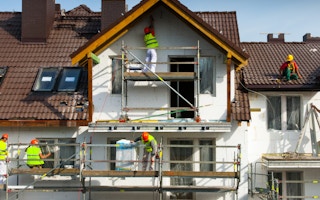The buildings and construction sector consumes more than a third of global energy used by final consumers, excluding the energy sector itself, according to United Nations climate experts.
While the energy intensity of the buildings sector—that is, how much energy is used to generate one dollar of economic output—has risen in recent years, experts are concerned that improvements are not keeping up with the pace of construction and a growing demand for energy services.
Buildings-related carbon dioxide emissions have continued to rise by around 1 per cent per year since 2010, and more significantly, over 4 million deaths worldwide each year are attributable to illness from household air pollution caused by burning coal to produce electricity.
Furthermore, the International Energy Agency estimates that within the next 40 years, the world will add 230 billion square metres in new construction every week—the equivalent of adding a Paris to the planet.
But international agreements such as the Paris Agreement and the Sustainable Development Goals have helped draw attention to the role the industry has had in driving climate change, and businesses are increasingly taking part in the fight to protect the natural environment.
Dutch multinational paints and performance coatings company AkzoNobel, for instance, is developing cleaner and greener paints and coatings. Its exterior paints now come with a solar-reflecting properties that help reduce the surface temperature of walls by up to 5 degrees Celsius, resulting in less heat build-up indoors and, consequently, less energy required for air-conditioning.
AkzoNobel produces household name products such as Dulux paint, aims to become carbon neutral by 2050. While it invests heavily in research and development—nearly 2 billion Euros in five years between 2012 to 2017—it recognises that it cannot achieve its goal alone.
Oscar Wezenbeek, managing director at AkzoNobel decorative paints, South-East and South Asia, tells Eco-Business that partnership for sustainability is central to AkzoNobel’s business. “However, over 90 per cent of our carbon footprint is accumulated from our suppliers, making our target to reduce our carbon footprint by 25-30 per cent by 2020 a big challenge,” he says.
That is why AkzoNobel introduced a supplier management process criteria in 2017 to ensure its suppliers meet the company’s standards in quality, delivery, innovation and sustainability.
The firm also collaborates with like-minded partners whether they are raw material suppliers, energy generation companies or even competitors, to reduce carbon emissions from its business, adds Wezenbeek.
Energy is one of AkzoNobel’s single biggest operational costs, and while 40 per cent of its energy needs are met by renewable sources, the company has committed to being 100 per cent powered by renewable energy by 2050.
The Dutch firm is aiming to partner other companies in order to create demand for renewable energy in parts of the world where it operates, says Wezenbeek.
Efforts include Project ENVISION, a consortium launched by 13 partners including AkzoNobel to harness solar irradiance reflected by the surfaces of buildings for energy, using panels that come in lighter and brighter colours compared to existing solutions
AkzoNobel joined hands with the World Green Building Council (WGBC), a global non-profit organisation, and its global network of green building councils in different countries to encourage the construction of energy efficient, sustainable buildings, via a series of sustainability-focused thought-leadership discussions and showcases
Collaboration for disruption
But more of the same will not be enough to bring about a sustainable building and construction industry, and a bolder approach and new ideas are necessary, comments Wezenbeek.
With this in mind, AkzoNobel this year launched Paint the Future, an innovation challenge searching for early-stage tech companies and institutes that it can team up with to find new, innovative paint solutions to tackle real world challenges.
Wezenbeek says the challenge is an “open invitation” to start-ups and other organisations to work together on new technologies that would help bring about real change into the buildings and construction space and help slow global warming.
And start-ups and innovators have responded to the coatings company’s call for collaboration. AkzoNobel received 160 submissions from around the world, each aiming to answer the call for solutions in one of five key areas: smarter coatings applications, enhanced functionality for cleaner, more responsive or adaptive coatings, circular solutions, life science infused technologies for coatings, and solutions for more predictable performance of coatings.
The winning solutions were smart coatings from SAS Nanotechnologies; an automated printing head for coating large surfaces from QLayers; di-block polymers that tune surface functionality from Interface Polymers; the autonomous drone from Apellix; Alucha Recycling Technologies’ solution for turning waste into bio-oils and minerals; and Octo’s digital solutions for inspections.
These creative, game-changing solutions exemplify the need for collaboration.
Wezenbeek says: “We need to reach out to find those new technologies and innovations we haven’t thought of yet, or that we have so far considered too complicated to realise by ourselves.”


















